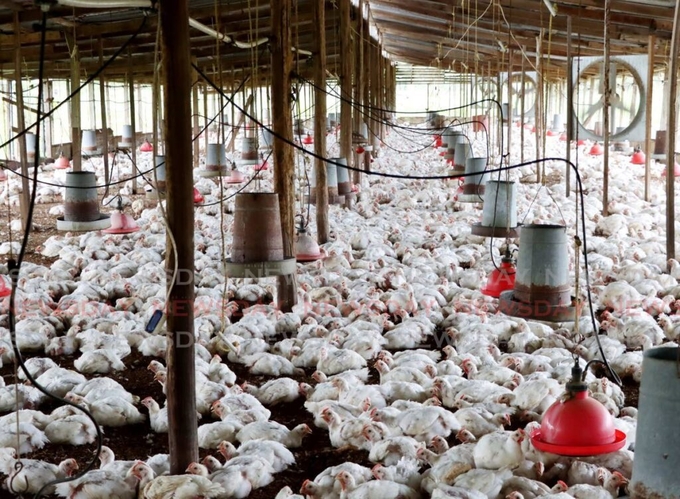May 14, 2025 | 07:45 GMT +7
May 14, 2025 | 07:45 GMT +7
Hotline: 0913.378.918
May 14, 2025 | 07:45 GMT +7
Hotline: 0913.378.918

Chickens at a poultry house in Wallerfield. Photo: Ayanna Kinsale
Caricom chair and President of Guyana Irfaan Ali has pointed out that the import of poultry meat is the region's third most expensive import product, at a value of US$750 million.
In TT, the agricultural sector, with poultry as its mainstay, contributes significantly to the nation's GDP.
With a consumption rate of a million chickens per year, comprising 750,000 locally produced and 250,000 imported, the sector's health is a matter of national importance.
However, despite its significant contribution to the GDP and employment, the poultry industry faces numerous challenges that affect both contracted and non-contracted farmers.
These challenges range from financial strains and modernisation hurdles to environmental impacts and issues with governmental support.
The poultry industry is at a crossroads, balancing between sustaining local production and managing competition from imports.
Industry insights
The poultry sector recorded expansion in the number of broilers produced during fiscal 2023 when compared to the same period in fiscal 2022.
In 2023, 43,946,152 broiler heads were produced, up from 43,495,834 in 2022.
This increase in broiler production can be attributed to an increase in demand for chickens by the fast-food industry and the growing trend by grocery chains to offer pre-cooked and ready-to-eat chicken to customers.
The sector also plays a crucial role in employment, directly supporting tens of thousands of regional jobs.
Market dynamics and industry sentiments
President of the Broiler Growers Association Sudesh Ramkissoon said the poultry industry is experiencing a decline in attractiveness to younger generations, with many potential farmers deterred by the high entry costs and shrinking opportunities.
“The industry is getting harder,” Ramkissoon said. “A lot of current farmers feel trapped, because this field can accumulate a lot of debt.”
Ramkissoon said second- and third-generation farmers are not interested in continuing in the field.
Contracted farmers, such as Ramkissoon, who get paid every 90 days, face financial instability.
Notably, there is a gradual phasing out of contracted farmers in favour of company-owned farms.
Contracted farmers
Speaking with Business Day, Ramkissoon highlighted several critical challenges faced by those under contract with larger companies.
Low remuneration rates make it difficult for farmers to sustain their operations and maintain profitability.
“In the value chain of the industry, we generate the least amount of revenue, despite being the ones who hold the chickens for the longest,” Ramkissoon said.
“After they stay in the hatchery for 21 days, farmers actually keep them for six weeks before they’re sent to the processing plant,” he explained.
Attempts to rally for better payment have led to threats against their farms or quiet firing, fostering a hostile environment for any advocacy efforts.
Another contracted farmer, who preferred to stay anonymous, said scores of his livestock have been poisoned as a result.
“I lost over $40,000 after culling through. I haven’t said anything since, because this is how I provide for my family.”
Additionally, the modernisation of farming infrastructure presents a significant financial hurdle.
Traditional pens cost between $300,000 and $600,000, while modern, tunnel-ventilated pens, like those used by larger companies such as Arawak, demand an investment of about $2 million.
Tunnel ventilation is a technique used in the poultry industry to prevent heat stress in animals. Given the tropical climate in the Caribbean, tunnel ventilation is used to lower the temperature in poultry houses and to keep humidity at an optimal level.
The system uses a wind-chill effect where air is blown through the house using end gable fans. The airflow cools the birds and reduces humidity to increase the level of comfort.
“A lot of the pens we have are inherited from family members who were farmers themselves,” another farmer said.
“If we were to develop these to be like the ones you see Arawak using, we would have to take out a loan from the bank. But because we don’t make that much, we often get denied.”
This stark financial disparity hinders contracted farmers from competing effectively with more technologically advanced operations.
The risk of E. coli outbreaks further exacerbates their operational difficulties, posing a constant threat to their livestock and overall farm viability.
Non-contracted farmers
Non-contracted farmers, operating independently, face severe economic challenges that affect their daily operations.
Feed prices are particularly burdensome, with each bag costing around $260. Non-contracted farmers need approximately 70 bags of feed per 1,000 chickens, adding substantial financial strain.
Despite these high costs, farmers cannot compromise on the quality of feed, as it directly affects the quality of the chickens, which is critical for maintaining market standards and customer satisfaction.
Dinesh Samaroo, a non-contracted farmer who runs his own pluck shop in Princes Town, said trying cheaper feed alternatives had affected the quality of his chickens.
“I tried going with a cheaper mix, but you could actually see them start to look sicker. They weren’t as plump and their feathers were much more dull. The meat of the bird was also much tougher.”
The combination of high feed costs and the need to maintain high standards puts immense pressure on non-contracted farmers, making it difficult to achieve financial stability.
Impact of environmental factors
Both contracted and non-contracted farmers face significant environmental challenges that affect their operations such as water shortages, droughts, heat and disease.
Water shortages and droughts are particularly problematic during the dry season, causing a lack of water for both cleaning and feeding livestock.
The Water and Sewerage Authority (WASA) supplies water primarily to residents, not farms, and the truck-borne supplies they provide are insufficient for even one day’s needs on a farm. Contractors sometimes supplement water supplies to farms or reduce the number of chicks provided to help manage the shortfall.
While flooding has not been a major issue, the intense heat presents a significant challenge. Chickens do not sweat, so rising temperatures lead to dehydration and higher mortality rates among livestock.
The heat also exacerbates the risk of E. coli outbreaks, as higher temperatures create favourable conditions for the bacteria to thrive.
“E. coli is a silent killer. It waits for just the right temperatures to attack the birds,” Samaroo said.
For non-contracted farmers, rising temperatures have had severe impacts. Many have experienced livestock fatalities caused by excessive heat.
“In 2023 due to the heat in the dry season, I culled almost 40 birds every day,” another non-contracted farmer said.
In response, some farmers have implemented quality-control systems to ensure all livestock have access to clean drinking water and remain healthy and active. They also ensure brooder systems are not too hot for young chicks.
Governmental support, institutional challenges
When it comes to support from governmental institutions like the Ministry of Agriculture, there is a notable difference in the experiences of contracted and non-contracted farmers.
Speaking at the opening of the Caribbean Poultry Symposium on May 14, Minister of Agriculture Kazim Hosein said, “Chickens in TT get the VIP treatment.”
While both contracted and non-contracted farmers alike did not agree with him, they understood where the comment stemmed from.
“Look at Arawak’s pens, for instance. It’s a very fancy and technological system, but the reality isn’t as glamorous.”
Contracted farmers recognise that while support exists, the processes to access it are excessively slow, hindering timely assistance that could mitigate some of their operational challenges.
Non-contracted farmers, on the other hand, feel largely neglected.
The application processes for government assistance programmes are often complex and fail to consider the realities faced by small-scale farmers. These processes lack clear information, support, and follow-up, making it difficult for farmers to benefit from available programmes.
Many non-contracted farmers, particularly older ones, are excluded due to a reliance on modern communication methods such as social media, which they seldom use. This communication gap leaves them unaware of potential support and unable to access necessary resources.
What ripple effect has this caused?
Poultry’s farmers’ struggles have had a domino effect in different areas of TT’s economy. Local pluck shops, groceries and consumers have noticed these effects.
Groceries
Supermarket Association president Rajiv Diptee said consumers are enjoying poultry products on a more periodic basis as opposed to its being a staple in their diets.
“There has been a shift. People buy fresh poultry products more on a monthly basis as opposed to a fortnightly basis like before.”
Diptee said there is also a preference for chicken that has been skinned and deboned in advance.
“People today don’t have the time to do the traditional thing of sitting down with a whole chicken and cleaning it. We’re seeing they’re opting for chicken that has been prepared in advance.”
Owner of Best Deals grocery in San Fernando Suresh Ramdhanie said he has noticed a generational difference in what poultry products people buy.
“For instance, we see people below the age of 35 buying things like chicken that has been cleaned and seasoned already."
Ramdhanie said people under 35 have a preference for chicken by-products, which are imported.
“We’ve seen people opting for chicken by-products like nuggets and patties over conventional chicken. It’s just faster for them.
“Also, because of all the adverts on television, they’re opting to go with foreign brands like Tyson. They feel a bit more comfortable with it.”
Pluck shops
Pluck shops have said they are also noticing changes in the industry.
The owner of Crystal’s pluck shop in Couva, Crystal-Anne Mukesh, said processing costs have gone up, which in turn is reflected in pricing.
“These machines they use to depluck chickens are extremely sensitive, and because they’re doing it in such high volumes to send to places like KFC or Royal Castle, we get whatever is left, and it's expensive because companies are trying to make a profit regardless of who it is."
Mukesh said she does not want to incur a loss as a result.
"If I get a chicken for $50, I'll sell it back for $60. It's unfortunate, but that's how it is."
She said she has noticed a decline in profits because of this.
"Not many people buying as often as they used to.
"In fact, most have set up their own mini-farms at home to take care of their needs."
Consumers
Consumers have felt the brunt of changes in the industry through high prices for poultry products.
David Rampersad, a fitness enthusiast, said he does not buy it as often as before.
"I've noticed it's affected my ability to put on muscle, but I'd rather slowly build my way up than go bankrupt buying meat."
"I don't buy it as often as I used to, honestly," one person said at a grocery.
"It's expensive. The chickens are really small for what they're priced at."
newsday

(VAN) India is concerned about its food security and the livelihoods of its farmers if more US food imports are allowed.

(VAN) FAO's Director-General emphasises the need to work together to transform agrifood systems.

(VAN) Europe is facing its worst outbreak of foot-and-mouth since the start of the century.

(VAN) The central authorities, in early April, released a 10-year plan for rural vitalization.

(VAN) Viterra marked a significant milestone in its carbon measurement program in Argentina, called Ígaris, reaching 1 million soybean hectares measured.

(VAN) Minnesota study adds to growing evidence of human-accelerated erosion, which could jeopardize agriculture.

(VAN) QU Dongyu addresses International Conference of the Global Mountain Dialogue for Sustainable Development in Kyrgyzstan.